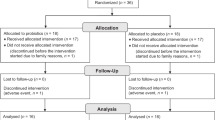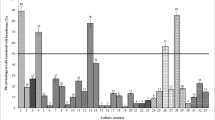Summary
Twenty healthy volunteers participated in a comparative study concerning the influence ofLactobacillus acidophilus supplements on the normal intestinal microflora after the administration of two antimicrobial agents, enoxacin and clindamycin, respectively.L. acidophilus NCFB 1748 was given as a fermented milk product containing 5 × 108−2 × 109 CFU/ml to ten of the volunteers immediately after the administration of the antimicrobial agents. On the seventh day of enoxacin administration enterobacteria were eliminated in nine of ten subjects. Enterococci disappeared or decreased significantly in five subjects. During theL. acidophilus supplementation, there was a significant increase in the number ofEscherichia coli in one subject, while enterococci returned to the same level as before enoxacin administration in all subjects. In the clindamycin group, the anaerobic microflora was strongly suppressed in all volunteers. Lactobacilli disappeared in two subjects and decreased in five. Administration ofL. acidophilus resulted in a significant increase in the number of lactobacilli in all subjects, while most other anaerobic bacteria returned to the same levels as before clindamycin administration one week later. In two subjects, Bacteroides increased to earlier high levels on days 14 to 16 in theLactobacillus group, while there was no similar increase in the clindamycin group. Though there was a partial restoration of the intestinal microflora due to the reestablishment of lactobacilli and enterococci,L. acidophilus administration could not accelerate the normalization of most other strongly suppressed microorganisms in the intestine.
Zusammenfassung
Bei 20 gesunden freiwilligen Probanden wurde der Einfluß vonLactobacillus acidophilus auf die physiologische Mikroflora des Darmes nach Gabe von zwei antimikrobiellen Substanzen, Enoxacin bzw. Clindamycin, im Rahmen einer Vergleichsstudie untersucht.L. acidophilus NCFB 1748 wurde in einer Konzentration von 5 ×108 − 2 × 109 KBE/ml als fermentiertes Milchprodukt unmittelbar nach Gabe der Antibiotika an zehn der Probanden verabreicht. Bei neun der zehn Probanden waren am siebten Tag nach Gabe von Enoxacin Enterobakterien eliminiert. Bei fünf Personen verschwanden Enterokokken oder waren signifikant vermindert. WennL. acidophilus zugegeben wurde, kam es bei einer Person zu einer signifikanten Zunahme derEscherichia coli-Zahlen und in allen Fällen zu einem Anstieg der Enterokokkenzahlen auf Werte wie vor der Applikation von Enoxacin. Bei allen Probanden der Clindamycin-Gruppe war die anaerobe Mikroflora erheblich vermindert. Bei zwei Personen verschwanden Laktobazillen und gingen in fünf Fällen zurück. Bei allen Testpersonen führte die Gabe vonL. acidophilus zu einem signifikanten Anstieg der Laktobazillen, die meisten anderen anaeroben Bakterien waren nach einer Woche wieder in derselben Zahl vorhanden wie vor Gabe von Clindamycin. Bei zwei Personen derLactobacillus-Gruppe stieg die Zahl der Bacteroides-Keime an den Tagen 14–16 auf Werte wie vor Antibiotikagabe an, während in der Clindamycin-Gruppe kein vergleichbarer Anstieg zu verzeichnen war. Obwohl es durch Regeneration der Laktobazillen und Enterokokken zu einer teilweisen Wiederherstellung der intestinalen Mikroflora kam, konnte durch Gabe vonL. acidophilus die Normalisierung der meisten übrigen, stark supprimierten Mikroorganismen im Darm nicht beschleunigt werden.
Similar content being viewed by others
References
Nord, C. E., Heimdahl, A., Kager, L. Antimicrobial induced alterations of the human oropharyngeal and intestinal microflora. Scand. J. Infect. Dis. 49 (1986) 64–72.
van der Waaij, D. Colonization resistance of the digestive tract. Clinical consequences and complications. J. Antimicrob. Chemother. 10 (1982) 263–270.
Hentges, D. J., Stein, A. J., Casey, S. W., Que, J. U. Protective role of intestinal flora against infection withPseudomonas aeruginosa in mice: influence of antibiotics on colonization resistance. Infect. Immun. 47 (1985) 118–122.
Heimdahl, A., Nord, C. E. Effect of phenoxymethylpenicillin and clindamycin on the oral, throat and faecal microflora of man. Scand. J. Infect. Dis. 10 (1979) 233–242.
Sutter, V. L., Finegold, S. M. The effect of antimicrobial agents on human faecal flora: Studies with cephalexin, cyclacillin and clindamycin. In:Skinner, F. A., Carr, J. G. (eds.): The normal microbial flora of man. Society for Applied Bacteriology, Symposium Series, No. 3. Academic Press, New York 1974, pp. 229–240.
Metchnikoff, E. The prolongation of life. Putnam, New York 1908.
Rettger, L. F., Levy, M. N., Weinstein, L., Weiss, J. E. Lactobacillus acidophilus and its therapeutic application. Yale University Press, New Haven CT 1935.
Lidbeck, A., Gustafsson, J.-Å., Nord, C. E. Impact ofLactobacillus acidophilus supplements on the human oropharyngeal and intestinal microflora. Scand. J. Infect. Dis. 19 (1987) 531–537.
Pettersson, L., Graf, W., Sewelin, U. Survival ofL. acidophilus NCDO 1748 in the human gastrointestinal tract. 2. Ability to pass the stomach and intestinein vivo. In:Hallgren, B. (ed.): XV Symp. Swed. Nutr. Found. Almqvist & Wiksell, Uppsala 1983, pp. 127–130.
Wolfson, J. S., Hooper, D. C. The fluoroquinolones: Structures, mechanisms of action and resistance, and spectra of activityin vitro. Antimicrob. Agents Chemother. 28 (1985) 581–586.
Bartlett, J. G., Sutter, V. L., Finegold, S. M. Treatment of anaerobic infections with lincomycin and clindamycin. N. Engl. J. Med. 16 (1972) 1006–1010.
Jalling, B., Malmborg, A. S., Lindman, A., Boréus, L. O. Evaluation of a micromethod for determination of antibiotic concentrations in plasma. Eur. J. Clin. Pharm. 4 (1972) 150–157.
Davies, B. I., Maesen, F. P. V., Teengs, J. P. Serum and sputum concentrations of enoxacin after single oral dosing in a clinical and bacteriological study. J. Antimicrob. Chemother. 14 Suppl C (1984) 83–89.
Sosa, A., Tally, F. P., Jacobus, N. V., Gorbach, S. L. Bacteroides fragilis resistance to clindamycinin vitro. Antimicrob. Agents Chemother. 22 (1982) 771–774.
Savage, D. C. Microbial ecology of the gastrointestinal tract. Ann. Rev. Microbiol. 31 (1977) 107–133.
Hentges, D. J. Does diet influence human fecal microflora composition? Nutr. Rev. 38 (1980) 329–336.
Goldin, B. R., Swenson, L., Dwyer, J., Sexton, M., Gorbach, S. L. Effect of diet andLactobacillus acidophilus supplements on human fecal bacterial enzymes. J. Nat. Cancer Inst. 64 (1980) 255–261.
Gotz, V. P., Romankiewics, J. A., Moss, J., Murray, H. W. Prophylaxis against ampicillin-induced diarrhoea with a lactobacillus preparation. Am. J. Hosp. Pharm. 36 (1979) 754–757.
Rolfe, R. D., Helebian, S., Finegold, S. M. Bacterial interference betweenClostridium difficile and normal fecal flora. J. Infect. Dis. 143 (1981) 470–475.
Yost, R. L., Gotz, V. P. Effect of a lactobacillus preparation on the absorption of oral ampicillin. Antimicrob. Agents Chemother. 28 (1985) 727–729.
Pradhan, A., Majumdar, M. K. Metabolism of some drugs by intestinal lactobacilli and their toxicological considerations. Acta Pharmacol. Toxicol. 58 (1986) 11–15.
Edlund, C., Lidbeck, A., Kager, L., Nord, C. E. Comparative effects of enoxacin and norfloxacin on human colonic microflora. Antimicrob. Agents Chemother. 31 (1987) 1846–1848.
Carlstedt-Duke, B., Alm, L., Høverstad, T., Midtvedt, A.-C., Norin, K. E., Steinbakk, M., Midtvedt, T. Influence of clindamycin, administered together with or without lactobacilli, upon intestinal ecology in rats. FEMS Microbiol. Ecol. 45 (1987) 251–259.
Foster, T. L., Winans, L., Carski, T. R. Evaluation of lactobacillus preparations of enterotoxigenicEscherichia coli-induced rabbit ileal loop reactions. Am. J. Gastroenterol. 73 (1980) 238–243.
Clements, M. L., Levine, M. M., Ristaino, P. A., Daya, V. E., Hughes, T. P. Exogenous lactobacilli fed to man — their fate and ability to prevent diarrhoeal disease. Prog. Food Nutr. Sci. 7 (1983) 29–37.
Zoppi, G., Deganello, A., Benoni, G., Saccomani, F. Oral bacteriotherapy in clinical practice. Eur. J. Pediatr. 139 (1982) 18–21.
Author information
Authors and Affiliations
Rights and permissions
About this article
Cite this article
Lidbeck, A., Edlund, C., Gustafsson, J.Å. et al. Impact of Lactobacillus acidophilus on the normal intestinal microflora after administration of two antimicrobial agents. Infection 16, 329–336 (1988). https://doi.org/10.1007/BF01644541
Received:
Accepted:
Issue Date:
DOI: https://doi.org/10.1007/BF01644541




